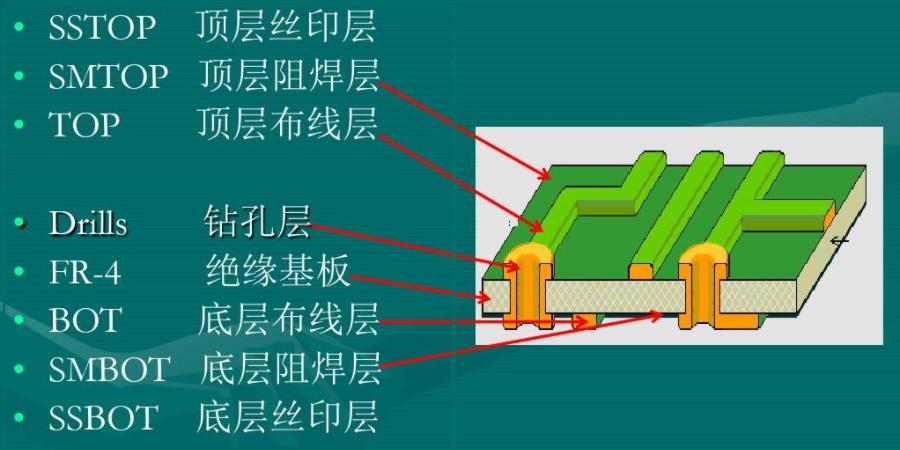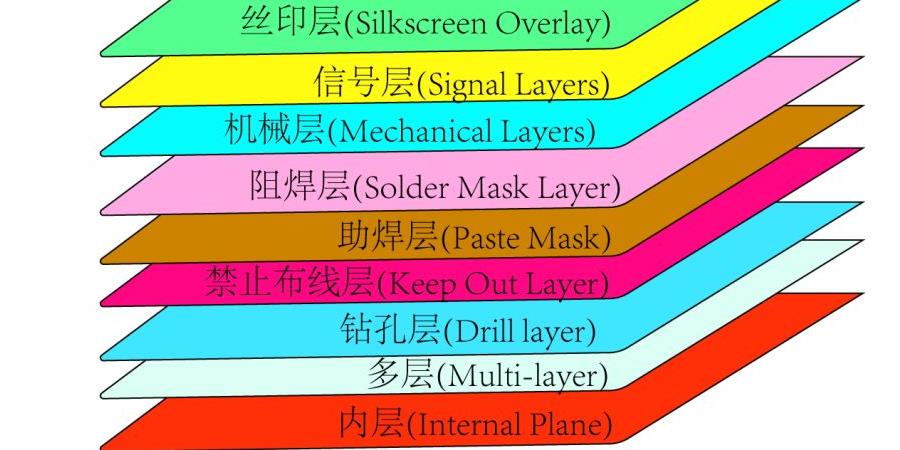What is PCB Solder mask?After a PCB is manufactured,the copper traces on the board are usually exposed to oxidation and corrosion risks due to exposure to the environment. The most reliable way to prevent this and extend the life of the PCB is to provide a protective coating of soldermask. The layer of paint on the surface of the PCB is called Solder Resist Ink, which is also known as PCB Solder Resist Ink.Soldermask is a very common and the main ink used in PCBs. Soldermask is generally 90% green, but there are also other colors, such as: red, blue, black, white, yellow, which is called mixed color ink.
The role of soldermask is to insulate, in the soldering process,to prevent short-circuiting due to bridge connection, physical breakage of conductor circuits,alignment due to dust,moisture and other external environmental factors cause insulation deterioration,corrosion and so on.
In the long run, dust and other contaminants may cause short circuits.Soldermask is a thin layer of polymer placed on a circuit board to protect the copper from oxidation and short circuits during operation,and it also protects the PCB board from environmental influences.

PCB Layers
Types of PCB Solder Resist Layers
1.Top and Bottom Soldermasks
PCB engineers often use these to identify openings in the green soldermask that has been applied to the PCB. This particular soldermask is added by means of an epoxy resin or film method. Next, the component pins are soldered to the board using the openings that have been registered with the mask.
The alignment at the top of the circuit board is called the top alignment and the corresponding soldermask used is called the top mask. Like the top mask, the bottom mask is used on the bottom of the board.
2.Epoxy Liquid Solder Resists
The most cost-effective choice of soldermask is epoxy resin. It is a polymer that is screen printed on the PCB circuit board.Screen printing refers to a printing technology that uses a woven mesh to support an ink-blocking pattern. The mesh identifies the open areas used in the ink transfer process. This step is followed by heat curing.
3.Liquid Photo Imaging (LPI) Solder Resists
The LPI resist is actually a mixture of two different liquids. These liquids are stored separately and mixed before applying the mask layer to extend the shelf life. LPI is also one of the more cost-effective options among various other types.
Used in curtain coating, screen printing and spray coating applications, LPI is a mixture of various polymers and solvents. A thin coating layer can be formed using this mask that adheres to the surface of the target area. With this mask, the PCB usually does not require any of the currently available final surface treatments.
Unlike conventional epoxy inks, LPI is sensitive to UV rays. The panel needs to be covered with a mask and after a short “tack-curing cycle” the PCB circuit board is exposed to UV light using a UV laser or photolithography process.
Before applying the mask, the panel is cleaned and inspected for any signs of oxidation. This is done by scrubbing the panel with a chemical solution, an aluminum oxide solution, or by using a suspended pumice stone.
One of the most popular technologies used to expose the panel surface to UV light is the use of film tools and contact printers. The top and bottom sheets of the film are printed using an emulsion to block off areas that need to be soldered. The production panel and film are then secured in place using tools on the printer and exposed to a UV light source at the same time.
One method utilizes direct imaging using lasers. This technique does not require tools or film because the laser is controlled through the use of datum marks placed on the panel's copper template.
LPI masks are available in a variety of colors such as green, black, red, yellow, white and blue.
4.Dry Film Optical Imaging Soldermasks
Vacuum lamination is required for the use of dry film LPI masks, which are exposed and then developed. After development, the openings are identified to generate patterns and then the components are soldered to copper pads. High-density circuit boards benefit from dry film soldermask because it does not flood the vias.
5.Surface Finishes
Regardless of the type of PCB soldermask used, the final soldermask will leave some exposed areas of copper on the board. These exposed areas need to be plated with a suitable surface finish to prevent oxidation. One of the most popular surface finishes is Hot Air Solder Leveling (HASL).
Other surface treatments such as electroless nickel palladium impregnated gold (ENEPIC) and electroless nickel impregnated gold (ENIG) can also be used upon request. If required, additional holes are left in the mask layer for the paste mask. The paste mask is used to attach pads or other components to the board depending on the manufacturing technique used.
PCB Soldermask Production Process
The following is the process of applying soldermask on PCB circuit board.
1.PCB Cleaning
Clean the circuit to remove dirt and other contaminants, and then dry the board surface.
2.Soldermask Coating
Next, the board is loaded into a vertical coating machine for soldermask coating. The thickness of the coating depends on factors such as the required reliability of the PCB and its area of use.The thickness varies when a soldermask layer is added to different parts of the board, such as alignments, copper foils or substrates.The thickness of the mask layer will depend on equipment capabilities and PCB manufacturing capabilities.
3.Pre-hardening
This stage is different from full hardening because pre-hardening appears to make the coating relatively strong on the pcb circuit board,which helps to remove unwanted coatings that can be easily removed from the PCB during the development stage.
4.Imaging and hardening
Imaging is done using laser drawn photographic film to define the soldermask area. The film is aligned with a panel that has been coated with solder ink and dried. During this imaging process, the film aligned with the panel is exposed to UV light. Upon receiving the UV light, the opaque area allows the UV light to pass through the film, which causes the ink underneath the opaque area to polymerize (harden).
In the case of LDI imaging, there is no need for photographic film because the UV laser will directly harden the portion of the board that needs to be preserved with soldermask.
5.Development
The board is then immersed in a developer solution to remove the unwanted soldermask and ensure accurate exposure of the required copper foil.
6.Final Hardening and Cleaning
When mounted on the PCB surface, final hardening is required to make the soldermask available. Next, the boards that have been covered with soldermask need to be cleaned and then subjected to further processing, such as surface preparation.

PCB Layers
Soldermask design
1.Through-hole
When a through-hole is covered by a soldermask so that it is not exposed, it is called a tented through-hole. Unlike a filled via, here only the ring is covered by the soldermask. If the hole is completely closed, it is referred to as a filled via or a mask blocked via, depending on the method used to close the hole.
Canopy vias are a popular process used to protect PCBs, and for cost reasons it is chosen to be filled with epoxy resin or blocked with a mask. Among the through-hole augmentation methods, liquid photoimaging (LPI) soldermask augmentation is the most cost-effective.
To ensure better tenting through, you can also use more costly resin fills.
The purpose of vias is to leave fewer exposed conductive pads on the PCB surface, which will minimize short circuits that occur during solder bridging during assembly. When the through-hole is located at the edge of the pad or standard BGA “dogbone” pattern, tin has a migration from the SMT pad is also reduced, the tent can also minimize the through-hole due to exposure to the operating environment and the possibility of damage.
2.Soldermask Gap
Soldermask gap is a tolerance that determines the proximity of the soldermask to the PCB surface features. The purpose of this tolerance gap is to provide sufficient spacing between the surface features that receive solder, called solder dams. This prevents the formation of solder bridges.
Solder Resist Gap
Normally the soldermask gap needs to be half the width of the conductor pitch. When using fine conductor patterns of 100 μm or less, the solder resist gap can be less than 50 μm, which is a good idea, since it can be used for a wide range of conductor patterns.
3.Solder Pads
The soldermask defines pads as those with mask openings smaller than the copper pads, so that the soldermask will define the size of the pads used in the BGA.
Changes in the mask gap will determine the size of the copper pads.
Non-resist defined pads include the gap between the pad and the mask.
The soldermask process needs to consider fit tolerances so that the mask gap should always be larger than the pad. This is necessary to keep the entire pad free of solder resist and to ensure optimal soldering.
4.Soldermask Windowing
The outer layer of the PCB without the mask is called the soldermask opening and its purpose is to expose the circuitry to tin (solder). This opening must be accurate, otherwise it can lead to unwanted copper exposure on the board, which can lead to corrosion and damage.
Typically, manufacturers choose copper pads with 1:1 soldermask openings that can be changed to the appropriate manufacturing technique. The opening must be customized to the requirements, otherwise the grounding layer next to the pad may be exposed. This may result in a short circuit and should be prevented.
5.Soldermask Coverage or Extension
EDA software can usually configure the spacing between the board surface features and the soldermask. This specification is often referred to as soldermask spread and can be positive, negative or zero.
Positive soldermask expansion, when there is a distance between the end of the soldermask and the outer circumference of an uncovered pad, is called positive soldermask expansion.
Zero soldermask expansion, when there is no spacing or gap between the soldermask and the pad, it is a zero value.
Negative soldermask expansion, when the soldermask overlaps an area of the pad, it is negative.
PCB Solder Resistance Design Impact on PCBA Manufacturing
Both sides of the PCB are copper layer, no soldermask PCB exposed in the air is easy to be oxidized, and become defective products, but also affects the electrical performance of the PCB. In this case, the PCB surface must have a layer of PCB and air to prevent the occurrence of oxidation reaction of the protective coating layer, and this layer is covered with soldermask paint data soldermask layer. The role of the soldermask in controlling soldering defects during the PCBA soldering process is very important, and PCB designers should minimize the spacing or air gap around the pad features. Inappropriate PCB soldermask design can lead to the following PCBA defects.
1.Soldermask is too thick to exceed the thickness of the PCB copper foil pads, which will form bridges and open circuits when reflow soldering.
2.Poor alignment of solder resist processing and pads, resulting in contamination of the pad surface, resulting in poor solder pickup or a large number of solder balls.
3.When there are wires passing between two pads,PCB soldermask design should be adopted to prevent soldering short circuit.
4.When there are two or more SMDs close to each other,the pads share a common lead, the application of soldermasking to separate them,so as not to produce stress when the solder shrinkage of the SMD shifted or cracked.
The above is about the introduction of PCB soldermask and PCB soldermask on the impact of PCB manufacturing,I hope to be able to be useful to everyone.